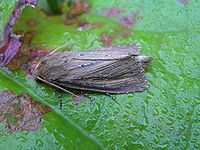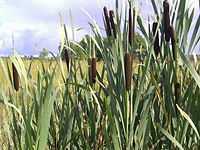Nonagria typhae
| Nonagria typhae | |
|---|---|
| | |
| Scientific classification | |
| Kingdom: | Animalia |
| Phylum: | Arthropoda |
| Class: | Insecta |
| Order: | Lepidoptera |
| Family: | Noctuidae |
| Genus: | Nonagria |
| Species: | N. typhae |
| Binomial name | |
| Nonagria typhae (Thunberg, 1784) | |
| Synonyms | |
| |
The Bulrush Wainscot (Nonagria typhae) is a moth of the Noctuidae family. It is found from Ireland and Portugal to southern Fennoscandia, east to western Siberia, the Altai Mountains, Yakutia, Turkey, the Caucasus, Lebanon, Egypt, Arabia, Iraq, Iran, Afghanistan and central Asia.


The wingspan is 45–50 mm. Adults are on wing from July to October.
The larvae feed on Typha latifolia and Typha angustifolia.[1]
Description
"The fore wings of this species (Plate 144. Fig 5), usually of a pale whity-brown colour, in some specimens are reddish tinged; or they may be almost uniformly reddish brown or blackish (var. fraterna Treit.). The row of black spots on the outer area are wedge-shaped and are placed just before the margin. The caterpillar is pale ochreous more or less tinged with pink; a paler line along the spiracles ; head and plate on first ring of the body red-brown. July to August, in stems of Typha. The moth flies in August and September, and although it may be netted when on the wing at dusk, or at light, it is obtained in better condition by rearing it from the chrysalis, which may be found in the stems (Plate 148, Fig. 3), those of the previous year for choice, of reed mace." South, 1907.[2]
References
External links
- Lepiforum
- Funet Taxonomy
- Fauna Europaea
- UKmoths
- Species info
- Butterflies and Moths of Northern Ireland
| Wikimedia Commons has media related to Nonagria typhae. |